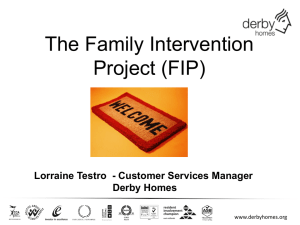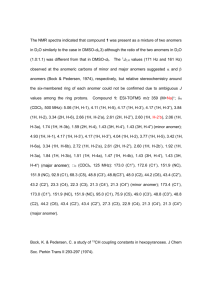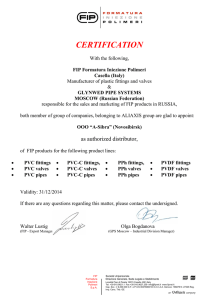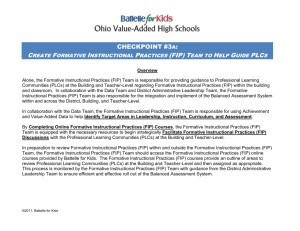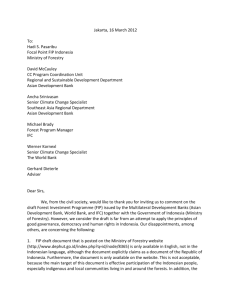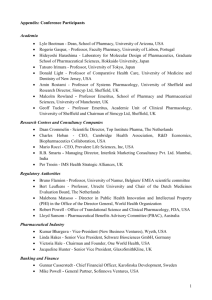Formative Instructional Practices
advertisement
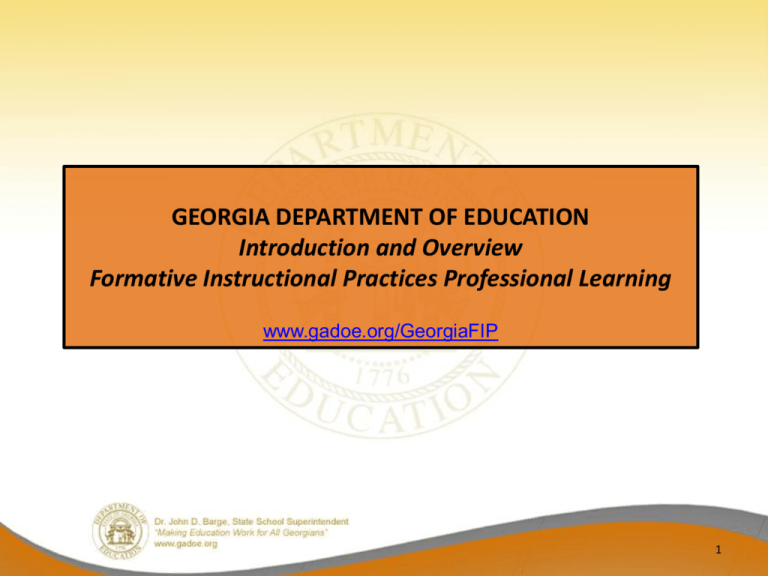
GEORGIA DEPARTMENT OF EDUCATION Introduction and Overview Formative Instructional Practices Professional Learning www.gadoe.org/GeorgiaFIP 1 Goals of the Session • Share an overview the GaDOE Assessment initiatives • Define FIP, communicate the goals of FIP, and provide an overview of Formative Instructional Practices (FIP) Professional Learning • Share connections to existing improvement efforts in Georgia • Identify best practices that are associated with FIP • Provide information about the FIP web page, resources and FIP access codes for districts and buildings • Share considerations for implementation 2 Background - Georgia’s Assessment Initiatives • Purpose – To provide assessment resources that reflect the rigor of Georgia’s state-mandated content standards – To balance the use of formative and summative assessments in the classroom – To promote student learning – To sustain implementation of Georgia’s rigorous content standards 3 Georgia’s Assessment Initiatives Continued… • Development of a three-prong toolkit to support teachers and leaders in promoting student learning – *An assessment literacy professional learning opportunity that focuses on implementation of research-based formative instructional practices (FIP) – Initial Pilot January/February 2013 with statewide launch 2013-2014 – A set of interim benchmarks in ELA, Math – Initial Pilot Fall 2013 – An expansive bank of formative instructional assessment items/tasks based on CCGPS in ELA and Mathematics as a teacher resource - Phase I Release Fall 2012; Phase II release Fall 2013 4 Goals of Georgia FIP • Support the development of great teachers and leaders in their work towards College and Career Readiness • Refine and augment teaching and learning processes based on researchproven practices • Facilitate a quality implementation of Georgia’s state-mandated content standards • Increase the alignment between Curriculum, Instruction and Assessment • Implement the principles for Universal Design for Learning (mastery of the learning process) • Support Georgia’s Teacher Keys Effectiveness System (TKES) and (TAPS) • Support Georgia’s Leader Keys Effectiveness System (LKES) and (TAPS) • Support the work on Student Learning Objectives and Measures Formative Instructional Practices Defined It is not the instrument that is formative; it is the use of the information gathered (Chappuis, 2009). Formative Instructional Practices (FIP) are intentional behaviors that teachers and students use to obtain information about learning so that decisions can be made about additional learning opportunities. Formative instructional practices are the formal and informal ways that teachers and students gather and respond to evidence of student learning. Georgia’s FIP professional learning has four major components. 1. 2. 3. 4. Clear Learning Targets Collecting, analyzing and using evidence of student learning Effective Feedback Student Ownership of Learning 6 The alternative is to use many different assessment methods to provide students, teachers and parents with a continuous stream of evidence of student progress in mastering the knowledge and skills that underpin or lead up to state standards. Stiggins, 2005 Phi Delta Kappan 7 Formative Instructional Practices (FIP) Summative Assessment • Re-Design • Teach Formative Assessment/ Diagnostic Georgia’s Rigorous Curriculum Formative Assessment • Re-Design • Teach • Design • Teach Formative Assessment Formative Assessment • Re-Design • Teach 8 How GaDOE Started: FIP Advisory Committee • Advisory Committee identified based on need to represent various geographic regions of the state • 10 small, medium and large districts • Participated in a series of face-to-face and webinar meetings to guide planning the implementation • Began implementation in January 2013 • Provided feedback to DOE on successes and challenges of FIP pilot to incorporate into the statewide implementation in summer 2013 9 FIP Advisory Committee Pilot Metrics June 4, 2013 • • • • • • • • 325 educators participated in FIP online learning 176/325 identified themselves as teachers (54%) 12/325 identified themselves as leaders (4%) 10/325 identified themselves as coaches (3%) 113/176 teachers completed modules 1-5 (64%) 196/325 of all enrollees completed FIP (60%) 64/325 in progress with online learning (20%) 65/325 scheduled to begin online learning (20%) 10 Educators are Talking about FIP… Spring 2013 Advisory Committee “It was eye opening to see that even educators have a hard time clearly defining what counts as formative instruction and summative instruction.” “This module helped me understand what learning targets are and how they can be helpful to both the teacher as well as the student. It also informed me of how to make learning targets more clear and how to "break down" a standard into smaller and more manageable parts.” “This module did a great job of demonstrating how teachers are to accurately collect and document formative evidences of student learning. The videos and activities made connections that were easy to understand as a teacher.” “I would love to see a requirement tied to this in terms of professional learning in groups within a school and school level leadership. I think this component is critical if this is going to be effective in changing teacher practices when implementing in the classroom.” 11 FIP Connections Current Improvement Efforts 12 FIP Alignment to TKES 13 FIP Alignment to LKES 14 FIP Connection: Self-assessments TAPS Self-assessment Depending upon the standards that a teacher identifies for growth, the supervisor can offer or recommend applicable FIP online learning modules to consider in the pre-conference. LAPS Self-assessment and Performance Goal Setting Leaders can consider if FIP professional learning is an appropriate compliment for the performance goals they will establish and/or reflect upon how FIP can support the school improvement plan. 15 FIP Connection: SLO Design (FIP Professional Learning Content Support in Italics) Ten Steps for Designing an Effective SLO Measure http://www.gadoe.org/School-Improvement/Teacher-and-LeaderEffectiveness/Documents/QG_Teachers%20SLOs%20for%20Teachers%204-1-2013%20FORMATTED.pdf 1. Unpack the standards (Modules 1 & 2) 2. Create a table of specifications (Module 3) 3. Clarify why, when, and where to assess student learning (Module 3) 4. Determine appropriate items to use (Module 3) 5. Determine number of items to use (Module 3) 6. Write valid and reliable items (Module 3) 7. Assemble the measure (Module 3) 8. Construct scoring key and/or rubric (Module 3) 9. Administer the measure (Module 3) 10. Score and analyze results (Module 4) 16 FIP Connection: SLOs • FIP Learning Modules 1 and 2 • TKES Standards 1, 2, 3, 4, 8 and 10 SLOS are directly aligned to the most important content standards that students should learn in a course. FIP Professional learning content on deconstructing standards by target type and establishing a logical learning progression helps teachers plan and deliver focused and differentiated instruction based on the needs of students. Teachers become better prepared to communicate with parents about current academic standing and plans for growth. 17 FIP Connection: SLOs • FIP Learning Modules 3, 4 and 5 • TKES Standards 5, 6, 7, 9 and 10 FIP professional learning content supports work efforts for SLOs. It provides teachers a process for developing classroom formative assessments* to monitor progress so that appropriate instructional adjustments can be made in a timely manner. The impact of teaching upon student growth will be observed when post-SLO measures are taken. *Option to use Formative Item Bank in OAS 18 Let’s Talk About FIP 19 Foundations Modules: Formative Instructional Practices 1. Introduction to Formative Instructional Practices • Understand what formative instructional practices are • Become familiar with key research findings related to the effects of formative instructional practices on student achievement 2. Clear Learning Targets • Understand the benefits of learning targets • Know how to ensure learning targets are clear to the teacher • Know how to make learning targets clear to students 20 Foundations Modules: Formative Instructional Practices 3. Collecting and Documenting Evidence of Student Learning • Know how to collect accurate formative evidence of student learning • Know how to document formative evidence of student learning 4. Analyzing Evidence and Providing Effective Feedback • Know how to use methods of assessment formatively in order to analyze evidence of student learning • Understand what makes feedback effective • Know how to provide effective feedback 21 Foundations Modules: Formative Instructional Practices 5. Student Ownership of Learning: Peer Feedback, Self-Assessment, and More • Know how to prepare students to give each other effective feedback • Know how to prepare students to self-assess with a focus on learning targets • Know how to prepare students to create specific and challenging goals • Know how to prepare students to track, reflect on, and share their learning with others 22 Leadership and Coaching Modules: Formative Instructional Practices 6. Leading Formative Instructional Practices • Know how to promote formative instructional practices and support school-wide change • Know how to lead quality formative instructional practice implementation in your school • Understand the importance of developing a balanced assessment system Target audience: Facilitators, district and school leaders 23 Leadership and Coaching Modules: Formative Instructional Practices 7. Coaching Formative Instructional Practices • Know how to plan for the change process and to promote a systemic approach to formative instructional practices. • Know how to leverage blended learning and professional learning teams. • Understand how to sustain the implementation of formative instructional practices. • Know how to provide teachers with effective feedback as they learn about formative instructional practices. • Know how to employ resources and strategies that support formative instructional practices. Target audience: Facilitators, instructional coaches, curriculum supervisors, department heads, district and school leaders 24 Learning Options for FIP 25 Learning Paths * Recommended for Optimum Learning Teacher Learning Paths 1. Professional Learning Team (Modules 1-5) * 2. With Friends (Modules 1-5) 3. On my Own (Modules 1-5) Coaches and Teacher-Leader Learning Paths 1. Coaching FIP for Student Success (Modules 1-5, and 7) District, School and Instructional Leader Learning Paths 1. Leading FIP for Student Success (Modules 1-7) * 2. FIP Leadership Essentials (Modules 1 & 6) 26 Learning Components *Recommended for Professional Learning Team (PLT) • Pre-Activity • Online Module Completion * • Confirming Learning (online) management) * Ensures that educators have met the learning targets of the modules. • Confirming Commitment* Helps educators set goals and take action based on what they’ve learned from the modules. • Reflection • My Learning Folder Collects evidence of professional learning and implementation. • Confirming Practice * Facilitates reflection and discussion about educator practice. 27 Formative Instructional Practices are Best Practices Best Practice LEARNING TARGETS ARE CLEAR • Students can answer the question, “Where am I going?” 29 Best Practice EVIDENCE OF STUDENT LEARNING IS COLLECTED AND DOCUMENTED • Students use this evidence to answer the question, “Where am I now?” 30 Best Practice FEEDBACK IS EFFECTIVE • Students use effective feedback to answer the question, “Am I on the right path?” 31 Best Practice STUDENTS TAKE OWNERSHIP OF THEIR LEARNING • Students can answer the question, “What do I need to do to be successful?” 32 Best Practice Everyone—including teachers, students, leaders, and parents—uses and understands formative instructional practices. 33 Best Practice Schools embrace a collaborative culture that supports teachers’ efforts to improve their practice. Teachers work together to embed formative instructional practices based on Georgia’s curriculum in their classrooms, learn from each other, and develop shared expectations of what students should know and be able to do. 34 Best Practice Parents are clear about the learning targets and understand what their child should know and be able to do. As a result, they can better support their child’s learning at home. 35 Best Practice Leaders model and support the practices they want teachers and students to master. School leaders provide effective feedback, establish clear learning targets, and create structures that foster success. 36 Getting Started with FIP Online Professional Learning Access Codes, District Implementation and PLU Credit 38 Accessing Georgia FIP The district’s Assessment Director or Testing Coordinator serves as the GaDOE FIP liaison. The Assessment Director downloads from the GaDOE Portal the unique and role-specific FIP online access codes for the central office, and for each school. Access codes allow FIP learners to create individual accounts by name, work email address, and password to access FIP online learning and/or use the management functions of the online system. If a school in the district has been consolidated or is a new school, work though your district’s assessment director to have this resolved. The assessment director will contact GaDOE for assistance. Types of Access Codes District Office Administrative/Learner (Online Monitoring/Management) District/Central Office Learner Code (Central Office Staff) School Leader Administrative/Learner Code (Principal) School Learner Code (Teachers) 39 Accessing Georgia FIP • • • • • • Visit www.gadoe.org/GeorgiaFIP to download directions for creating an account as a new user; “New Users-GA FIP Login Directions.” On the Georgia FIP web page, locate, “Login to FIP Professional Learning,” and use the directions for creating an account with your unique FIP Access Code. For more information on use of the administrative and management features in FIP, download the resource from the web page, “Monitoring Tool.” Access to the administrative features in FIP have also been provided for schoollevel principals through a unique school-level administrative code that is a different code from the access code that teachers will use for online learning in the school. After login, click “My Learning” to access the online modules. IT and login support is available at: support@battelleforkids.org or (866) 5437555. GADOE will begin to assume technical support in 2014 and more information will be provided. • 40 www.gadoe.org/GeorgiaFIP 9-minute video 41 New Users Login Directions from FIP Web Page 42 New Users Click, “Create A New Account” 43 44 Access Learning, Create Code Posters, Users Guide and Resources Take FIP Courses Monitor and management online learning 45 Example of School’s FIP Access Code Flyer for Learners to Distribute to Faculty with “New User Directions” 46 Online System User’s Guide 47 Tab for FIP Facilitation Guide 48 Tab for Supplemental Materials and Handouts 49 Facilitation Resource: Prior-to-Meeting “To Do List” 50 Facilitation Resource: Agenda Example 51 Facilitation Resource – Answer Key 52 Starting FIP in a District • Visit the FIP web site: www.gadoe.org/GeorgiaFIP • View the video of Dr. Barge and Georgia’s FIP Advisory Committee sharing their experiences with FIP professional learning. • Download the files, Overview of Georgia FIP Online Learning, and Getting Started Districts and Schools, to learn about the content for professional learning and implementation considerations. • Contact the district’s Assessment Director or Testing Coordinator to determine if the district has planned an implementation for FIP, and/or to obtain the appropriate FIP online access code for your role in the district. 53 Starting FIP in a District • Seek approval, if needed, for FIP implementation with key district leadership to build support for implementation. • Develop a plan and timeline for implementation and link FIP to existing improvement efforts and to TKES and LKES. Download the alignment of FIP to TKES and LKES from the FIP web page. • Think about how FIP can support a Priority, Focus, Alert and Reward school. • There are numerous ways to implement FIP in a district. • Consider how the RESA can assist with implementing FIP. 54 FIP Sample Implementation Plans Sample Plan #1 District Level: District Assessment Director/Testing Coordinator and district FIP Team present the informational PowerPoint to identified district-level staff who serve as FIP Contact Persons. FIP is implemented in FIP volunteer and/or assigned schools. FIP Contact Persons facilitate all modules, discussion and application of FIP strategies for school-level staff through a synchronous learning schedule. 55 FIP Sample Implementation Plans Sample Plan #2 District Level: District Assessment Director/Test Coordinator and FIP Team present informational FIP PowerPoint, and Module 1 to district leaders, principals and/or coaches in two different meetings. School Level: Principals take Modules 6 or 7 within a designated time frame. School principals are given the option to decide when to take, and how to lead Modules 15 with teachers using Professional Learning Teams. Principals share their FIP plans with district’s FIP Team , and continually update the district’s Team on school-level implementation. 56 FIP Sample Implementation Plans Sample Plan #3 RESA Level: Awareness - RESAs can facilitate ongoing activities and sessions to build an awareness of FIP in districts and explain how FIP supports existing educational improvement efforts in Georgia. Build Capacity – RESAs can offer professional learning communities for teachers, coaches and leaders that deepen understanding of the content of FIP and support educators in goal-setting and determining action steps for use of FIP strategies in schools and classrooms. 57 Recommended FIP PLU Credit 58 Other Considerations 1. 2. Involve the technology department from the onset. Identify the participants for FIP Professional Learning: (pilot, volunteers, cluster of schools needing improvement, selected teacher-leaders) 3. Consider the Learning Path Options: (1) Professional Learning Team (PLT), (2) With Friends, or (3) On My Own. (PLT is most successful method) 4. Determine a timeline for completion of each online module that includes: facilitation support, classroom practice, reflection, and discussion. 5. Consider and plan for local professional learning unit credits (PLUs). 6. Determine if funds exist for stipends or honorariums. 7. Organize a communication plan that links FIP to existing work. 8. Identify material needs for professional learning. 9. Use this PowerPoint and other tools on the FIP web pages for assistance. 10. Develop a method for obtaining feedback on implementation, and a monitoring system that includes use of the online administrative features in FIP. 59 Formative Assessment Initiatives Bringing a Balanced Assessment Focus to the Classroom Phase I items released into OAS fall 2012; Phase II items to be released in fall 2013 Formative Item Bank Assessment Literacy Professional Learning Interim Benchmark Assessments Pilot in winter 2013; Statewide launch in summer 2013 Phase I item pilot in fall 2013; Phase II pilot in winter 2014 60 Georgia Department of Education Formative Assessment Toolkit Team Dr. Melissa Fincher Associate Superintendent Assessment and Accountability 404.651.9405 mfincher@doe.k12.ga.us Dr. Dawn Souter Project Manager. RT3 Formative Item Bank 404.463.6667 dsouter@doe.k12.ga.us Dr. Melodee Davis Director Assessment Research and Development 404.657.0312 medavis@doe.k12.ga.us Dr. Jan Reyes Assessment Specialist, RT3 Interim Benchmark Assessments 404.463.6665 jreyes@doe.k12.ga.us Kelli Harris-Wright, Ed.S. Assessment Specialist, RT3 Assessment Literacy (FIP) 404-463-5047 kharris-wright@doe.k12.ga.us 61

